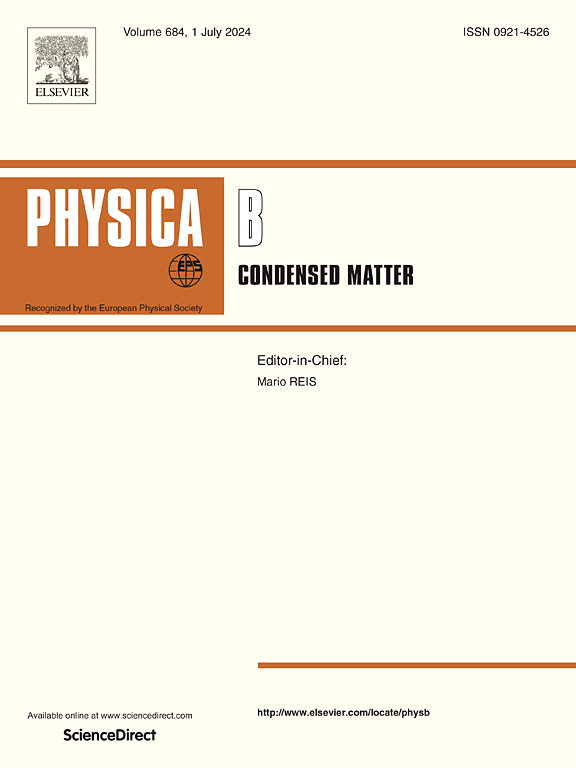Temperature dependent conversion from digital to analog resistive switching behavior of rf sputtered TiO2−x thin-film-based metal–oxide–semiconductor devices
IF 2.8
3区 物理与天体物理
Q2 PHYSICS, CONDENSED MATTER
引用次数: 0
Abstract
Substrate temperature driven digital to analog resistive switching behavior is observed in metal–oxide–semiconductor device in which TiO and Si act as gate oxide and substrate, respectively where 10-nm-thick TiO thin-films were deposited on -type Si (100) substrates by rf sputtering of TiO target at room temperature. Earlier, TiO deposition rate was calibrated using grazing incidence X-ray reflectivity (GIXRR) technique. In situ temperature dependent X-ray photoelectron spectroscopy (XPS) and room temperature photoluminescence techniques were employed to get concentration of oxygen vacancies and Ti. Current–voltage () and high frequency (HF) capacitance–voltage () properties were studied from room temperature to 200 °C. The data shows a change in nature of resistive switching behavior of the devices from its abrupt/digital to analog nature with increasing measurement temperature. It is observed that the digital switching appears beyond a certain temperature due to alignment of energized oxygen vacancies up to 150 °C. With further rise in temperature, a redistribution of vacancies takes place, responsible for creation of multiple conducting pathways leading to change the nature into analog one. A model is also proposed to explain such a change in its resistive switching nature. The HF data shows highest accumulation capacitance at RT due to the presence of maximum number of oxygen vacancies. The capacitance lowers down significantly at 50 °C and again starts increasing at 100 °C and maintains the rising trend up to 200 °C. This phenomena may be explained on the basis of temperature dependent reaction of oxygen vacancy with carbon impurities present in the device.

rf溅射TiO2−x薄膜金属氧化物半导体器件从数字到模拟电阻开关行为的温度依赖转换
在金属氧化物半导体器件中,TiO2和Si分别作为栅极氧化物和衬底,观察到衬底温度驱动的数字到模拟电阻开关行为,在室温下通过对TiO2靶材的射频溅射在n型Si(100)衬底上沉积了10纳米厚的TiO2薄膜。此前,TiO2的沉积速率采用掠入射x射线反射率(GIXRR)技术进行校准。采用原位温度依赖x射线光电子能谱(XPS)和室温光致发光技术测定了氧空位和Ti3+的浓度。在室温至200℃范围内研究了电流-电压(I−V)和高频(HF)电容-电压(C−V)特性。I - V数据显示,随着测量温度的升高,器件的电阻开关行为从突然/数字性质转变为模拟性质。我们观察到,在超过一定温度时,由于通电氧空位的排列,数字开关出现在高达150°C。随着温度的进一步升高,空位的重新分配发生,负责创造多种传导途径,从而将自然转变为模拟。还提出了一个模型来解释其电阻开关性质的这种变化。HF C−V数据显示,由于存在最大数量的氧空位,在RT处积累电容最高。电容在50°C时显著下降,在100°C时又开始增加,到200°C时保持上升趋势。这种现象可以根据氧空位与器件中存在的碳杂质的温度依赖反应来解释。
本文章由计算机程序翻译,如有差异,请以英文原文为准。
求助全文
约1分钟内获得全文
求助全文
来源期刊

Physica B-condensed Matter
物理-物理:凝聚态物理
CiteScore
4.90
自引率
7.10%
发文量
703
审稿时长
44 days
期刊介绍:
Physica B: Condensed Matter comprises all condensed matter and material physics that involve theoretical, computational and experimental work.
Papers should contain further developments and a proper discussion on the physics of experimental or theoretical results in one of the following areas:
-Magnetism
-Materials physics
-Nanostructures and nanomaterials
-Optics and optical materials
-Quantum materials
-Semiconductors
-Strongly correlated systems
-Superconductivity
-Surfaces and interfaces
 求助内容:
求助内容: 应助结果提醒方式:
应助结果提醒方式:


